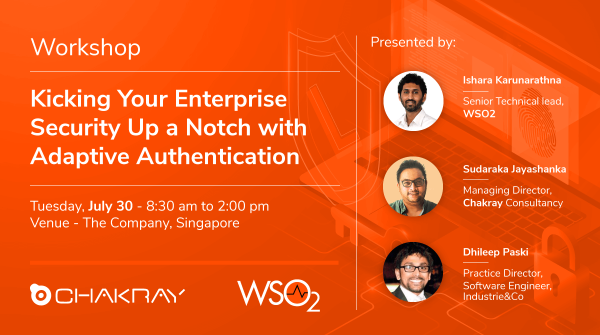Do you work in the field of internet security? Or are you interested in boosting your company’s online security? Perhaps you’re simply keen to learn more about this topic? In any case this workshop is for you!
WSO2 is collaborating with Chakray to host a workshop on security and adaptive authentication which you will not want to miss!
The Workshop
You can expect a comprehensive explanation of the current state of internet security, and existing authentication methods. Experienced industry professionals will explain the differences between authentication methods, and give advice on how to improve your enterprise’s security. The workshop will also feature a live demonstration of two factor authentication to help you gain a better understanding of the process. Attendees will be shown how the WSO2 Identity Server can be utilized to successfully implement adaptive authentication.
We will discuss the evolution of authentication mechanisms, the advantages and drawbacks that different authentication methods have, as well as explaining how adaptive authentication can be an answer to your enterprise’s security issues, and lower the risks of logging into web or mobile applications and endpoints.
The half-day workshop will begin with breakfast at 08:30am, before ending with a panel discussion just before lunch. It will be presented by Ishara Karunarathna, the Senior Technical Lead at WSO2.
In this workshop you can learn about:
Importance of online security
In the digital age, keeping our data secure from data breaches and hackers is becoming ever more important. Seemingly every week there is another news story about a significant data breach, putting millions of people’s personal data at risk of being either publicised, or utilised without their consent.
These data breaches can be financially damaging and emotionally challenging for the victims. Increasingly these breaches can also lead to huge financial penalties for the organizations responsible for that data and often overlooked these breaches can lead to a significant erosion of trust between organizations and their customers.
Multi-factor authentication and adaptive authentication
So is there anything that can be done to improve our online security, and ensure that our data stays safe from hackers? Of course there is, and the answer is Multi Factor Authentication (MFA). MFA is the most reliable way method of ensuring the security of personally identifiable information (PII). However, to date there have been several issues with MFA – most notably there have been issues with usability, and many people consider MFA a hassle.
The solution is adaptive authentication. Adaptive authentication is one way in which MFA can be configured and deployed, and a method for determining the correct authentication factors, based on a particular user’s risk profile. In other words, it means that adaptive authentication determines which authentication factors a user is presented with during the log-in process. This helps strike the right balance between a minimally disruptive user experience, and a sufficiently high level of security.
In this workshop you will learn about adaptive authentication, as well as several ways in which it can be implemented. One of these is Fast Identity Online, or FIDO.
Fast Identity Online (FIDO)
Fast Identity Online, or FIDO, is slowly but surely becoming the de facto standard for multi factor authentication. As a result, many large online companies have started to implement it as an internal security measure.
FIDO comes in many forms. For example, it can be implemented as part of a multi factor authentication scenario in which the server requests the user to unlock their device via touch, or facial recognition. In this case FIDO will be the second factor in a the multi factor authentication process. The advantage that FIDO has over many other authentication mechanisms, is that it uses information from the user’s person (finger print, facial recognition) as well as information from the user’s device, which adds an additional layer of security.
However, there are many different ways in which FIDO can be implemented in multi factor authentication. For example, when one tries to log into their account using a username and password, FIDO might also ask the user to unlock the device they are using, as a way to confirm their identity.
However due to persisting issues with user experience, FIDO hasn’t successfully conquered the mass market yet. Although promising ways in which FIDO’s usability may be improved in the future do exist.
Don´t miss out!
If these topics are relevant to your role or your organisation, please follow this link to register online for this free event. Places are very limited so please register soon to avoid disappointment.









